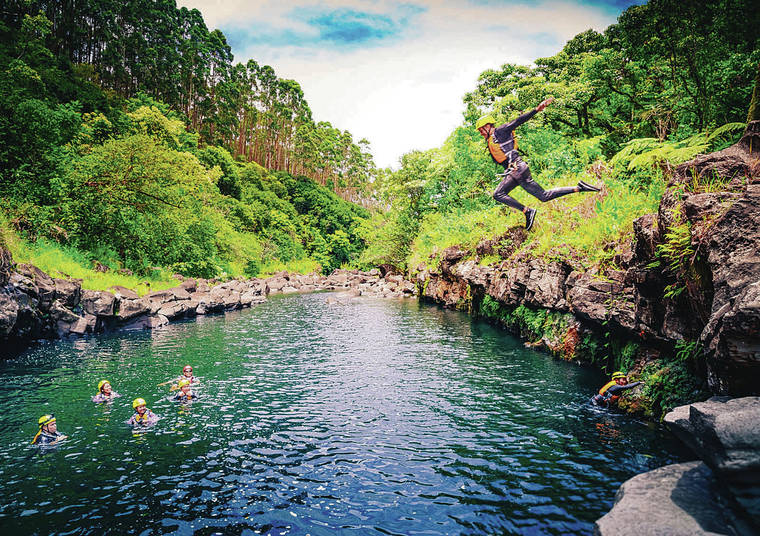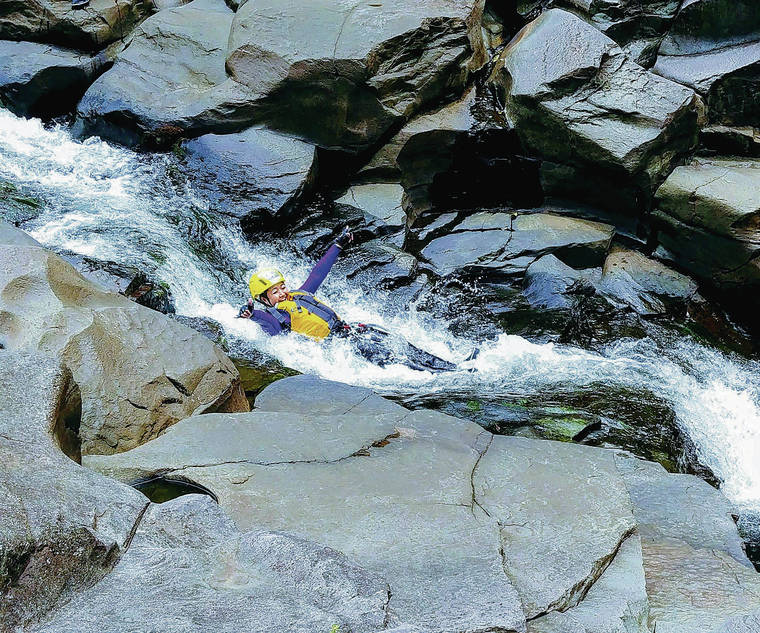First, you’ll rappel 125 feet to a scenic spot beside a waterfall in the Umauma River.
Then you’ll float to a nearby dam, which was built in 1910 to funnel water via an irrigation flume for use by the community.
Next, you’ll glide down a 16-foot natural stone slide and — if you’re game — jump 15 feet into a pond.
Following that, you’ll rappel down 35- and 25-foot waterfalls into the river before hiking to the final rappel site — a 20-foot drop into a waterfall-fed pool where you can swim before enjoying lunch.
Sound exciting? Ready to do it? An activity that literally takes you over the edge, the Umauma Experience’s Waterfall Rappel and River Tours are a must for visitors with a penchant for adventure.
“The Umauma River originates on the slopes of Mauna Kea,” said John McCollum, general manager of the Umauma Experience. “It’s one of the last of the ‘ever-flowing’ rivers on the Hamakua coast. As you travel north, most of the rivers are seasonal; they flow only during the winter rainy season. We offer fun activities in, over and around the river. Rappelling is the most thrilling of them.”
For the uninitiated, rappelling is descending a cliff or other near-vertical surface backward with a rope that’s secured at a higher point and, of course, with the proper harnesses, carabiners and other gear. Jean Esteril Charlet, a French climber, reputedly was the first to practice rappelling while exploring the French Alps in 1876. It is now popular worldwide for recreation and military and first responder training.
When the Umauma Experience decided to offer a rappelling tour in early 2017, renowned mountaineer Dave Black, who has written six books about canyoneering and rock and ice climbing, was retained to scout locations, help design the course and train guides.
Launched in May that year, the Waterfall Rappel and River tour takes guests to some of Hawaii island’s most beautiful and pristine settings for what’s billed as the ultimate playtime. Even better, prior experience is not required, top-notch equipment is provided and seasoned, knowledgeable guides share insights about the area and tips on how to rappel safely and smoothly.
“The Umauma Experience is the only place in Hawaii where you can swim in, zip line over and rappel down waterfalls,” McCollum said. “Yes, rappelling can be scary if you’ve never done it before. Yes, it requires concentration and physical effort. But as you’re doing it, literally one step at a time, you’re overcoming fears and anxieties, you’re getting a great workout and you’re feeling a sense of accomplishment and discovery about yourself: ‘Hey, I’m doing something I didn’t think I could do, and I’m having an awesome time to boot!’ ”
—
WATERFALL RAPPEL AND RIVER TOURS
>> Meeting place: Umauma Experience’s visitor center, 31-313 Old Mamalahoa Highway, Hakalau, Hawaii island
>> When: 10:30 a.m. weekdays (check in by 10 a.m.)
>> Cost: $285, including lunch; $275 for children through age 10. Children must be able to fit in the harness and cannot be younger than 8.
>> Info: 808-930-9477, email bookings@ziplinehawaii.com or go to umaumaexperience.com Opens in a new tab
—
TAKE NOTE
>> Provided: Wetsuits, towels, helmets, harnesses, floatation vests, water shoes, dry bags and belay devices. Bring a swimsuit to wear under the wetsuit.
>> Be aware: Tour includes hiking on boulders. Not recommended for pregnant women or those with neck, back or balance issues. Participants must be in good physical condition and weigh between 80 and 250 pounds.
>> Other tours: River Swim and Kayak; Umauma Falls Zipline Tour; Deluxe ATV Experience; Zip N Dip Ziplining and Kayak Tour; and a horseback tour with Wailea Horseback Adventures at Umauma.
>> Kamaaina discount: 20% on all tours.
>> Self-guided stroll: $12, along the river and through lush gardens.
—
HISTORY OF HAKALAU
Umauma Valley is in Hakalau, an ahupuaa (land division extending from the mountains to the sea) where crops such as taro, bananas, coconuts, sweet potatoes and sugar cane were cultivated in ancient times. There in 1791, the forces of Kamehameha the Great and High Chief Kekuhaupi‘o foiled what was intended to be a surprise attack by the warriors of Maui’s King Kahekili. That victory helped boost Kamehameha’s rise to power and quest to unify the Hawaiian islands.
During the Great Mahele (land redistribution) of 1848, Hakalau was awarded to Keahikuni Kekau‘onohi, granddaughter of Kamehameha I. When she died in 1851, her husband, Levi Ha‘alelea inherited her lands. After his death in 1864, all of the holdings, including Hakalau, were sold at auction.
The Reciprocity Treaty of 1875 guaranteed a duty-free market for Hawaiian sugar in the United States, and, hoping to snare a piece of that lucrative business, dozens of plantations began opening throughout the islands. Using the Umauma River and surrounding streams for irrigation, Hakalau Plantation Co. began operating in 1881. It merged with Pepe‘ekeo Sugar Company in 1963 and a decade later, Mauna Kea Sugar Company before finally closing in 1974.
Hakalau Forest National Wildlife Refuge was established in 1985 to protect native Hawaiian forest birds. Encompassing about 33,000 acres on Mauna Kea’s eastern slope between the 3,000- and 6,000-foot elevations, it preserves flourishing koa and ohia forests as well as 19 plant, invertebrate and mammal species listed in the Endangered Species Act.
The refuge is not open to the public, primarily to minimize the risk of introducing and/or spreading invasives that can harm native species.
Cheryl Chee Tsutsumi is a Honolulu-based freelance writer whose travel features for the Star-Advertiser have won several Society of American Travel Writers awards.






